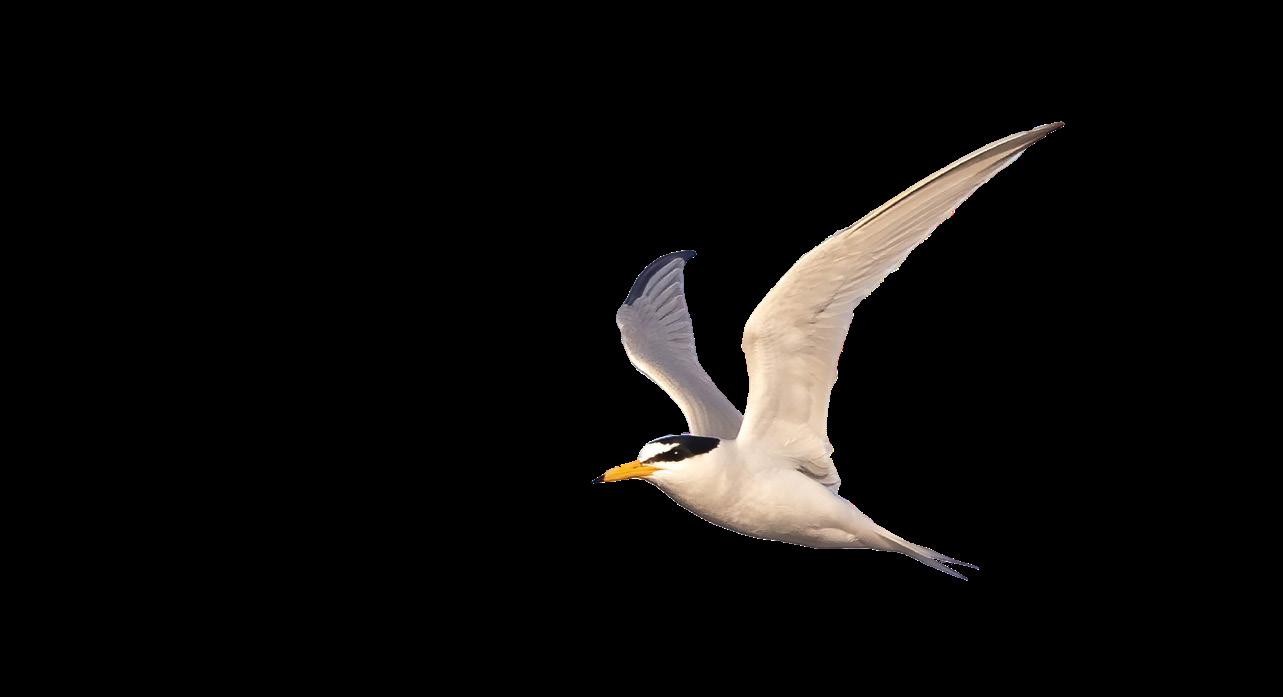
2 minute read
Turning terns easy!
By Sarah Harris, BTO
Here, we look at the identification of tern species in adult breeding plumage – how you would likely see them during the breeding season here in the UK. Hopefully, identifying adult birds in a mixed colony will be far less daunting with this short guide.
Starting with our largest breeding tern species, the Sandwich Tern. So named because of the mustard from their sandwich lunch, stuck on the tip of their beak... no, so named because they were first discovered in Sandwich, Kent. They breed on beaches and on wetlands adjacent to coastal areas. Although the majority of UK breeding birds spend the winter months off the west African coast, occasionally birds are seen around the UK coast of all year round.
Sandwich Tern


From the largest UK nesting tern to the smallest; Little Terns are little by name and little by nature. They are also fairly distinct from the other tern species. They nest on shingle and sand around UK coastlines but interestingly, outside of the UK, they are known to nest inland too. UK populations spend the winter months off west Africa. Little Terns have the distinctive behaviour of persistent hovering before diving to catch their prey.
The next three species are often seen as trickier to separate: Common, Arctic and Roseate Tern. Here we need to think about structure as well as plumage. Think about how compact they look when standing – are they compact and bull-necked like the Arctic Tern? Do they have tail streamers projecting beyond their wing tips, like the Arctic and Roseate Terns? Are their legs short (Arctic), medium length (Common) or long (Roseate)? Is their head rounded (Arctic) or more ‘flat-topped’ (Common and Roseate)?
Common Terns are fairly... common, and with smudges on their outer primaries and a dark tip to their bill, some even say they are ‘common as muck’ – looking less pristine (and more mucky) than the Arctic and Roseate Terns. Common Tern is the only species listed here to nest properly inland (from a UK perspective) on artificial rafts and lake islands, as well as at coastal sites. UK nesting birds winter off the coast of west and southern Africa.
The Arctic Tern has a name starting with the letter ‘A’, so too does the phrase ‘A ll red’ which perfectly describes this species’ beak. Cherry red, same as the legs – unlike the beaks of Common and Roseate Tern, which have a black tip or are mostly black, respectively. Arctic Terns are
Little Tern
compact and look as though they could almost topple forward and roll away (did someone say ‘Arctic Roll’?!). The majority of Arctic Tern breeding colonies are in the north, but some are further south too. This species has an impressive migration, wintering off the coast of South Africa and down into Antarctica!
Roseate Terns are the rarest of the UK nesting tern species, with a restricted breeding range, however,
COMMON TERN they can visit the colonies of the other tern species too. Shorter-winged and longer-tailed and legged than the Common and Arctic Terns, with pale grey, almost white, plumage above and rosy flush below, this species is slightly easier to distinguish from the Common and Arctic Terns than those two are to one another (sometimes known as ‘Commic Tern’ when ID is not possible). Roseate Tern nests on maritime coasts and UK populations winter off the coast of west Africa.



Inner primaries translucent
Short, forked tail
Id Videos
The BTO Training Team have created ID videos which are freely available online. These include tern identification. Access these at www.bto.org/ develop-your-skills/birdidentification/videos
To learn tern calls, visit www.xeno-canto.org
Dark wedge on outer primaries which becomes stronger as summer progresses
Red legs
Broad, diffuse trailing edge to primaries
Beak orange-red with black tip
ARCTIC TERN
Plain, deep red beak
Primaries plain, light grey, above, and translucent below Grey ‘wash’ below



ROSEATE TERN
Thin dark wedge on outer most primaries
Beak mostly black with red base in midsummer
Sharply defined, dark trailing edge to primaries
Long tail streamers Short, red legs
White trailing edge to primaries
Very pale grey mantle
Rosy flush below
Long tail streamers
Long, red legs










